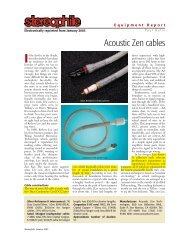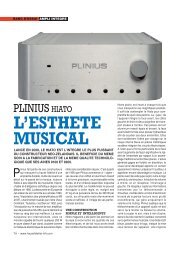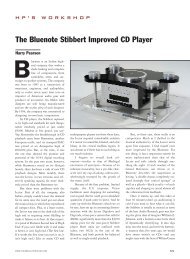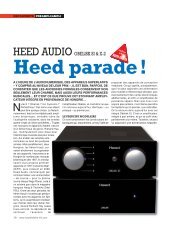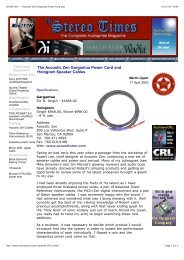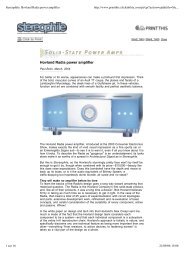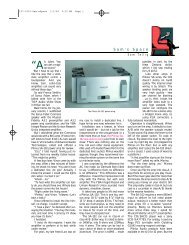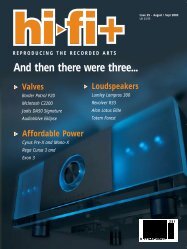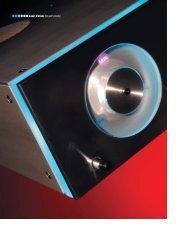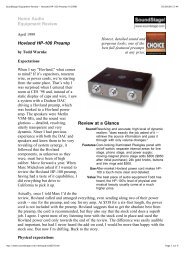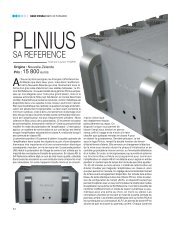Stereophile: Plinius SA-Reference power amplifier - Jason Diffusion
Stereophile: Plinius SA-Reference power amplifier - Jason Diffusion
Stereophile: Plinius SA-Reference power amplifier - Jason Diffusion
- No tags were found...
Create successful ePaper yourself
Turn your PDF publications into a flip-book with our unique Google optimized e-Paper software.
<strong>Stereophile</strong>: <strong>Plinius</strong> <strong>SA</strong>-<strong>Reference</strong> <strong>power</strong> <strong>amplifier</strong>http://www.printthis.clickability.com/pt/cpt?action=cpt&title=Ste...Bakels and the Bournemouth Symphony's recording of Vaughan Williams' SinfoniaAntartica (CD, Naxos 8.5507330) had spot-on roundness, richness, andprojection.Several tracks from Nick Drake's Bryter Layter (CD, Island IMCD 71/846 005-2)provided outstanding examples of the <strong>Plinius</strong>' capabilities. "Northern Sky" is abenchmark of intimacy and soulfulness. Drake's delicate acoustic guitar andsupple, melancholy voice did cause me to think I was listening to tubes. Whiletubes may give a whisker or two of additional palpability, a skeptic would have toaudition the <strong>SA</strong>-<strong>Reference</strong> back to back with a superior tube amp to notice thedifference. John Cale's vaporous, enchanting celeste on "Northern Sky" was assoothing and gentle as a soft breeze on a warm summer day in the countryside.The flute in the instrumental "Sunday" had a fetching and uncannily lifelikepresence in my room.The <strong>Plinius</strong> absolutely loved well-recorded voices. Eva Cassidy, Buddy Holly, k.d.lang, Jacqui McShee—all sounded unabashedly marvelous, and the increasedintelligibility of previously murky vocals was another standout trait. While JacquiMcShee's crystalline voice has always been easy to follow on "The Baron ofBrackney," from Pentangle's So Early in the Spring (LP, Green Linnet SIF 3048),I've always found Bert Jansch's Scots-inflected slurring considerably moredifficult to make out. The <strong>Plinius</strong> let me understand more of Jansch's words thanhave other amps I've used, even my reference Lamm M1.2 <strong>Reference</strong>.Article Continues:Page 2<strong>Plinius</strong> Audio Ltd.Web SiteUS distributor: Elite Audio VideoDistribution1027 N. Orange DriveLos Angeles, CA 90038> Page 1Page 2SpecificationsAssociated EquipmentMeasurements(800) 457-2577As noted above, Morrison and Thomson went back and forth with the treblevoicings of the various <strong>SA</strong>-250s; in the <strong>SA</strong>-<strong>Reference</strong>, they've struck a nearlyideal balance. This amp has unaccented and grainless highs—not too soft, nottoo forward, the amp's top octaves are now like Baby Bear's bed: just right. Evenin this day and age, one still occasionally encounters a solid-state <strong>amplifier</strong> thatdoesn't sound quite right on the harmonics generated by orchestral strings.Though they're not yet extinct, such amps are now much less frequentlyencountered than they were 15 or 20 years ago. In its silky delicacy andconvincing fullness of body, the <strong>SA</strong>-<strong>Reference</strong> represents the other end of thespectrum.Exceptional clarity and evenhandedness in the top octaves is a necessarypredicate to natural-sounding transient performance. The <strong>SA</strong>-Ref showedexceptional fidelity to live sound with its reproductions of plucked strings andpercussion. The mallet percussion in "The Duel with the Skeletons," from Journeyto the Center of the Earth: The Fantasy Film World of Bernard Herrmann (UK LP,London Phase 4 SP44207), was immaculately clean without any amp-suppliedcrispness. The isolated percussion points in A. Clyde Roller and the EastmanWind Symphony's recording of Hovhaness' Symphony 4 (Dutch LP, MercuryGolden Classics SRI 71050) hung luxuriously in the air. Acoustic guitars hadshimmer but avoided any edgy highlighting of the initial attack of plectrum onstring. Things sounded as fast as they do in real life, with no added illusion ofspeed.3 sur 11 21/09/06 14:11
<strong>Stereophile</strong>: <strong>Plinius</strong> <strong>SA</strong>-<strong>Reference</strong> <strong>power</strong> <strong>amplifier</strong>http://www.printthis.clickability.com/pt/cpt?action=cpt&title=Ste...Tube <strong>amplifier</strong>s are renowned for their ability to capture the sense of space thatthe best recordings provide, but the solid-state <strong>Plinius</strong> is far more than merelyrespectable in this sense. Julius Katchen's recording of Rachmaninoff'sRhapsody on a Theme of Paganini (with Sir Adrian Boult and the LondonPhilharmonic, UK LP, London CS 6153) sounds rather dark and distant, but the<strong>SA</strong>-<strong>Reference</strong> showed the deeply quiet background necessary to resolve thelow-level details that establish the shape and size of the soundstage. Theresolution of woodwind details deep in the orchestra was also notable.Image scaling is another area where the <strong>Plinius</strong> offered performance comparablewith the best of the best. When not pumping out lots of watts, a high-<strong>power</strong>edamp can sometimes blow up the size of an image or seem to flatten it a bit. The<strong>SA</strong>-Ref was capable of captivating intimacy on solo material such as BertJansch's "Needle of Death" and "Anji," from Bert Jansch/It Don't Bother Me (2albums on one UK CD, Transatlantic ESM CD407), or small-group recordings suchas Bill Evans' Waltz for Debby (<strong>SA</strong>CD/CD, Riverside/Analogue Productions CART9399 <strong>SA</strong>). Given expansive productions such as "Keep an Eye on Summer" and"Dream Angel," from Brian Wilson's Imagination (CD, Giant 24703-2), or Eiji Oueand the Minnesota Orchestra's traversal of Copland's Appalachian Spring (CD,<strong>Reference</strong> RR-93 HDCD), the <strong>SA</strong>-Ref readily conjured up in my room suitably largespaces populated with precisely located images.Bringing +300W to the dance should mean that the <strong>SA</strong>-<strong>Reference</strong> had a broaddynamic envelope, and it did. The most <strong>power</strong>ful moments of the VaughanWilliams, in particular the tuttis with organ in the third movement, had real majestyand grandiosity through the <strong>Plinius</strong>. Led Zeppelin IV's stomping Zen raga, "Whenthe Levee Breaks" (UK LP, Atlantic K50008), was just as potent and energizing.Softer but no less demanding dynamic contrasts were also managedexceptionally well. Bert Jansch's rasgueados in "Anji" had the snap and suddenloudness they should have but sometimes don't.Perhaps most important, the <strong>Plinius</strong> can run with the toppermost of thepoppermost megabucks amps in a crucial regard: It expended its efforts ongetting out of the way of music and letting the music speak for itself. For years,I've loved the wonderful Argo LP of Neville Marriner's performance of VaughanWilliams' Five Variants on Dives and Lazarus. Because Marriner wrings everydrop of drama and pathos from the piece, I've always tended to shortchangeLeonard Slatkin's performance of it with the Philharmonia Orchestra (CD, RCA61195-2). The <strong>Plinius</strong>' self-effacing qualities let me appreciate Slatkin's versionfor his taut and clear-eyed vision. Slatkin directs the listener's attention more tothe clarity of line and structure of Vaughan Williams' sound as architecture andsculpture, rather than to its capacity for tugging at the heartstrings. The <strong>Plinius</strong>(and its quite wonderful sibling, <strong>Plinius</strong>' CD-101 CD player) revealed Slatkin's4 sur 11 21/09/06 14:11
<strong>Stereophile</strong>: <strong>Plinius</strong> <strong>SA</strong>-<strong>Reference</strong> <strong>power</strong> <strong>amplifier</strong>http://www.printthis.clickability.com/pt/cpt?action=cpt&title=Ste...version as different but anything but inferior.Good on ya, <strong>Plinius</strong>I spend a lot of time reviewing cost-no-object gear—the really expensive stuff.Which makes a component like the <strong>Plinius</strong> <strong>SA</strong>-<strong>Reference</strong> all the more refreshingwhen I run into one. The <strong>SA</strong>-Ref may not have the last, endlessly minute degreeof palpability or treble resolution that vastly more expensive <strong>amplifier</strong>s such asthe Chord SPM 14000, Halcro dm58, or VTL Siegfried may have, but unless youconsistently listen with the finest of speakers in a superbly synergized andoptimized system, the difference is meaningless.The <strong>SA</strong>-<strong>Reference</strong>'s most winning quality is that it is so acutely close to thosemulti-megabuck amps in all of the ways that are most meaningful to musicalcommunication. I readily admit that, in terms of the normal world, the <strong>SA</strong>-Ref isstill expensive. But in the modern world of the High End, it is moderately pricedfor a statement-level product.When I reviewed the <strong>SA</strong>-250 Mk.IV in 2000, I discovered in <strong>Plinius</strong> a companythat consistently provided performance to challenge all comers, price be damned.I concluded that to buy a competing product only incrementally better wouldrequire shelling out a lot more money than you would for the <strong>Plinius</strong>.That observation is as true now as it was then. Combining as it does brute-force<strong>power</strong>, world-class finesse, superb build quality, and a genuine and engagingmusicality, the <strong>Plinius</strong> <strong>SA</strong>-<strong>Reference</strong> is one hell of an <strong>amplifier</strong>. It does manythings superbly, and nothing less than very, very well. To get what more sonicquality is available—and it's not very much—you'll have to spend multiples more.I recommend the <strong>SA</strong>-<strong>Reference</strong> with unabashed enthusiasm.Article Continues:Specifications<strong>Plinius</strong> Audio Ltd.Web SiteUS distributor: Elite Audio VideoDistribution1027 N. Orange DriveLos Angeles, CA 90038Page 1> Page 2SpecificationsAssociated EquipmentMeasurements(800) 457-2577Sidebar 1: SpecificationsDescription: Solid-state two-channel <strong>power</strong> <strong>amplifier</strong>. Output <strong>power</strong> (bothchannels driven, 20Hz–20kHz): 300Wpc RMS into 8 ohms (24.8dBW), 450WpcRMS into 4 ohms (23.5dBW); 1000Wpc RMS into 8 ohms (30dBW) in bridged andtrue balanced mono modes. Frequency response: 20Hz–20kHz, ±0.2dB, 0dB at0Hz, –3dB at 70kHz. Distortion: typically
MEDIUM VOLTAGE DIN Fuse-Links36kV, Current Limiting Back-Up Fuse-Links, 3.15 to 63 AmpsMV DINKEMA CertificateThis certificate refers to SFQDJ 36kV fuse-links, which are electrically identical to the new T range, other than the fuses are sealed for outdoor use, have a brownceramic body and use a 50N striker.Form No. 36kV DINPage 7 of 10Data sheet 720107
<strong>Stereophile</strong>: <strong>Plinius</strong> <strong>SA</strong>-<strong>Reference</strong> <strong>power</strong> <strong>amplifier</strong>http://www.printthis.clickability.com/pt/cpt?action=cpt&title=Ste...Fig.2 <strong>Plinius</strong> <strong>SA</strong>-<strong>Reference</strong>, small-signal 1kHz squarewave into 8 ohms.Fig.3 <strong>Plinius</strong> <strong>SA</strong>-<strong>Reference</strong>, balanced channel separation (10dB/vertical div., R–Ldashed).Even in class-A mode, the <strong>SA</strong>-<strong>Reference</strong> slightly exceeded its specified output<strong>power</strong> at 1% THD+noise, both channels driven at 1kHz, giving 320W into 8 ohms(25dBW) and 480W into 4 ohms (23.8dBW). With one channel driven, the <strong>Plinius</strong>delivered 740W into 2 ohms (22.7dBW). How the THD+N percentage changed withoutput <strong>power</strong> into these loads is shown in fig.4; the <strong>amplifier</strong> is clearly lesscomfortable with the 2 ohm load, though the additional distortion is still well below0.1% up to the clipping point.Fig.4 was taken with balanced drive. Remaining with balanced drive, fig.5 showshow the THD+N percentage changes with frequency into 8, 4, and 2 ohms at alevel of 15V RMS, which is where the distortion starts to rise out of the noisefloor, according to fig.4. Though the overall distortion levels are in the mainrespectably low, the <strong>amplifier</strong> clearly gets less linear as the output current andfrequency increase. This graph was taken with class-A output-stage bias;switching to class-AB increased the 8 ohm midrange THD+N figure from 0.004% inboth channels to 0.005% left and 0.0085% right. Switching then to unbalanceddrive increased the THD further, to 0.03% left and 0.015% right. None of thesefigures represents anything close to audible, but they do reveal some8 sur 11 21/09/06 14:11
<strong>Stereophile</strong>: <strong>Plinius</strong> <strong>SA</strong>-<strong>Reference</strong> <strong>power</strong> <strong>amplifier</strong>http://www.printthis.clickability.com/pt/cpt?action=cpt&title=Ste...inconsistencies in the <strong>SA</strong>-<strong>Reference</strong>'s fundamental linearity.Fig.4 <strong>Plinius</strong> <strong>SA</strong>-<strong>Reference</strong>, class-A operation, distortion (%)vs 1kHz continuousoutput <strong>power</strong> into (from bottom to top at 1W): 8, 4, 2 ohms.Fig.5 <strong>Plinius</strong> <strong>SA</strong>-<strong>Reference</strong>, class-A operation, THD+N (%)vs frequency at 15Vinto (from bottom to top): 8, 4, 2 ohms (right channel dashed).The nature of the distortion, however, is predominantly the subjectively benignthird harmonic (fig.6), even at high <strong>power</strong>s (fig.7). This spectrum was notsignificantly affected by switching the output-stage bias to class-AB. Only whenit came to high-frequency intermodulation did the <strong>Plinius</strong> falter very slightly, the1kHz difference component lying at –66dB (0.05%) with the <strong>amplifier</strong> in class-ABmode driving an equal mix of 19kHz and 20kHz tones into 4 ohms just belowvisible waveform clipping on the oscilloscope (fig.8).9 sur 11 21/09/06 14:11
<strong>Stereophile</strong>: <strong>Plinius</strong> <strong>SA</strong>-<strong>Reference</strong> <strong>power</strong> <strong>amplifier</strong>http://www.printthis.clickability.com/pt/cpt?action=cpt&title=Ste...Fig.6 <strong>Plinius</strong> <strong>SA</strong>-<strong>Reference</strong>, class-A operation, 1kHz waveform at 28.4W into 4ohms (top), 0.013% THD+N; distortion and noise waveform with fundamentalnotched out (bottom, not to scale).Fig.7 <strong>Plinius</strong> <strong>SA</strong>-<strong>Reference</strong>, class-A operation, spectrum of 50Hz sinewave,DC–1kHz, at 200W into 4 ohms (linear frequency scale).10 sur 11 21/09/06 14:11
<strong>Stereophile</strong>: <strong>Plinius</strong> <strong>SA</strong>-<strong>Reference</strong> <strong>power</strong> <strong>amplifier</strong>http://www.printthis.clickability.com/pt/cpt?action=cpt&title=Ste...Fig.8 <strong>Plinius</strong> <strong>SA</strong>-<strong>Reference</strong>, class-AB operation, HF intermodulation spectrum,DC–24kHz, 19+20kHz at 330W peak into 4 ohms (linear frequency scale).Other than that and my quibble over differences between the two channels'fundamental behaviors, the <strong>Plinius</strong> <strong>SA</strong>-<strong>Reference</strong> offers very good measuredperformance.—John Atkinson<strong>Plinius</strong> Audio Ltd.Web SiteUS distributor: Elite Audio VideoDistribution1027 N. Orange DriveLos Angeles, CA 90038Page 1Page 2SpecificationsAssociated Equipment> Measurements(800) 457-2577Find this article at:http://www.stereophile.com/solid<strong>power</strong>amps/506plinius/index.html<strong>SA</strong>VE THIS | EMAIL THIS | CloseCheck the box to include the list of links referenced in the article.11 sur 11 21/09/06 14:11



